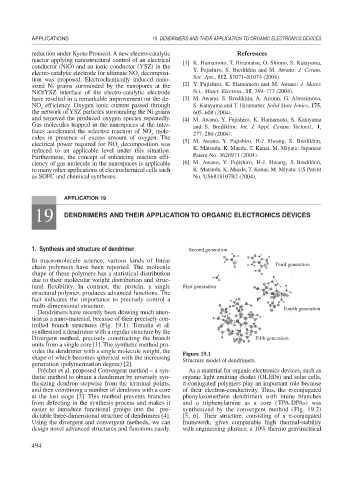Page 522 - Book Hosokawa Nanoparticle Technology Handbook
P. 522
APPLICATIONS 19 DENDRIMERS AND THEIR APPLICATION TO ORGANIC ELECTRONICS DEVICES
reduction under Kyoto Protocol. A new electro-catalytic References
reactor applying nanostructural control of an electrical [1] K. Hamamoto, T. Hiramatsu, O. Shiono, S. Katayama,
conductor (NiO) and an ionic conductor (YSZ) in the Y. Fujishiro, S. Bredikhin and M. Awano: J. Ceram.
electro-catalytic electrode for ultimate NO decomposi-
x
tion was proposed. Electrochemically induced nano- Soc. Jpn., 112, S1071–S1074 (2004).
sized Ni grains surrounded by the nanopores at the [2] Y. Fujishiro, K. Hamamoto and M. Awano: J. Mater.
NiO/YSZ interface of the electro-catalytic electrode Sci., Mater. Electron., 15, 769–773 (2004).
have resulted in a remarkable improvement on the de- [3] M. Awano, S. Bredikhin, A. Aronin, G. Abrosimova,
NO efficiency. Oxygen ionic current passed through S. Katayama and T. Hiramatsu: Solid State Ionics, 175,
x
the network of YSZ particles surrounding the Ni grains 605–608 (2004).
and removed the produced oxygen species repeatedly. [4] M. Awano, Y. Fujishiro, K. Hamamoto, S. Katayama
Gas molecules trapped in the nanospaces at the inter- and S. Bredikhin: Int. J. Appl. Ceram. Technol., 1,
faces accelerated the selective reaction of NO mole- 277–286 (2004).
x
cules in presence of excess amount of oxygen. The [5] M. Awano, Y. Fujishiro, H-J. Hwang, S. Bredikhin,
electrical power required for NO decomposition was
x
reduced to an applicable level under this situation. K. Matsuda, K. Maeda, T. Kanai, M. Miyata: Japanese
Furthermore, the concept of enhancing reaction effi- Patent No. 3626971 (2004).
ciency of gas molecule in the nanospaces is applicable [6] M. Awano, Y. Fujishiro, H-J. Hwang, S. Bredikhin,
to many other applications of electrochemical cells such K. Matsuda, K. Maeda, T. Kanai, M. Miyata: US Patent
as SOFC and chemical syntheses. No. US6818107B2 (2004).
APPLICATION 19
19 DENDRIMERS AND THEIR APPLICATION TO ORGANIC ELECTRONICS DEVICES
1. Synthesis and structure of dendrimer Second generation
In macromolecule science, various kinds of linear
chain polymers have been reported. The molecule Third generation
shape of these polymers has a statistical distribution
due to their molecular weight distribution and struc-
tural flexibility. In contrast, the protein, a single First generation
structural polymer, produces advanced functions. The
fact indicates the importance to precisely control a
multi-dimensional structure. Fourth generation
Dendrimers have recently been drawing much atten-
tion as a nano-material, because of their precisely con-
trolled branch structures (Fig. 19.1). Tomalia et al.
synthesized a dendrimer with a regular structure by the
Divergent method, precisely constructing the branch Fifth generation
units from a single core [1]. The synthetic method pro-
vides the dendrimer with a single molecule weight, the Figure 19.1
shape of which becomes spherical with the increasing Structure model of dendrimers.
generation (polymerization degree) [2].
Fréchet et al. proposed Convergent method – a syn- As a material for organic electronics devices, such as
thetic method to obtain a dendrimer by reversely syn- organic light emitting diodes (OLEDs) and solar cells,
thesizing dendron stepwise from the terminal points, -conjugated polymers play an important role because
and then combining a number of dendrons with a core of their electron-conductivity. Thus, the -conjugated
at the last stage [3]. This method prevents branches phenylazomethine dendrimers with imine branches
from defecting in the synthesis process and makes it and a triphenylamine as a core (TPA-DPAs) was
easier to introduce functional groups into the pre- synthesized by the convergent method (Fig. 19.2)
dictable three-dimensional structure of dendrimers [4]. [5, 6]. Their structure, consisting of a -conjugated
Using the divergent and convergent methods, we can framework, gives comparable high thermal-stability
design novel advanced structures and functions easily. with engineering plastics; a 10% thermo gravimetrical
494

